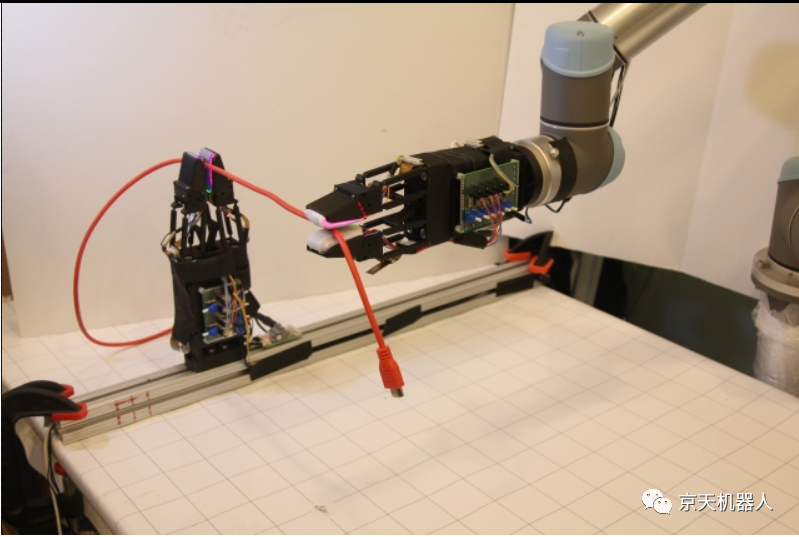MIT has developed a manipulator with soft and sensitive fingers that can handle cables with unprecedented flexibility.

For humans, manipulating small, flexible objects (such as ropes, wires, or cables) can be challenging. However, if these problems are difficult for humans to solve, then it is almost impossible for robots. When the cable slides between the fingers, its shape will constantly change, and the robot's fingers must constantly sense and adjust the position and movement of the cable.
The standard method uses a series of slow and incremental deformations and mechanical fixtures to complete the work. Recently, a group of researchers from the MIT Computer Science and Artificial Intelligence Laboratory (CSAIL) and the MIT Department of Mechanical Engineering conducted this research in a way closer to our humans from another perspective. The team's new system uses a pair of soft robotic grippers with high-resolution tactile sensors (no additional mechanical constraints) to successfully manipulate the freely moving cable.
Click the link to watch the video:https://mp.weixin.qq.com/s/nP_4LYHxJVBAVA-pgmeTlA
It is conceivable to use such a system to complete industrial and household tasks. One day, robots can help us tie knots, tie threads, and even perform surgical sutures.
The team’s first step was to create a novel two-finger gripper. The relative fingers are light and move quickly, and can adjust force and position flexibly and in real time. On the fingertips is a vision-based "GelSight" sensor, which is made of soft rubber with an embedded camera. The gripper is mounted on a robotic arm that can move as part of the control system.
The team’s second step was to create a perception and control framework to allow the cables to be manipulated. In order to sense, they used GelSight sensors to estimate the cable posture between the fingers and measure the friction when the cable slides. Two controllers operate in parallel: one controller adjusts the grip and the other adjusts the gripper posture to keep the cable in the jaws.
When mounted on the arm, the gripper can reliably follow the USB cable, starting from a random grip position. Then, combined with the second clamp, the robot can (like a human) "manually" move the cable to find the end of the cable. It can also be adapted to cables of different materials and thicknesses.
As a further demonstration of its prowess, the robot performed the actions that a human would normally perform when inserting earplugs into a mobile phone. Starting with a free-floating earplug-style cable, the robot can slide the cable between its fingers, stop when it feels the plug touches the finger, adjust the posture of the plug, and finally insert the plug into the jack.
"Manipulating soft objects is very common in our daily life, such as cable manipulation, cloth folding and knotting," said a postdoctoral fellow at MIT and the lead author of a new paper on the system. "In many cases, we want robots to help humans do this kind of work, especially when the task is repetitive, tedious or unsafe."
Cable follow
Cable following is challenging for two reasons. First, it needs to control the "grasping force" (to make sliding smooth) and the "grasping posture" (to prevent the cable from falling off the fingers of the gripper).
During continuous operation, it is difficult to capture this information from conventional vision systems because this information is often obscured, interpretation is expensive and sometimes inaccurate.
Moreover, only visual sensors cannot directly observe this information, so the team used tactile sensors. The joints of the grippers are also flexible to protect them from potential shocks.
The algorithm can also be extended to different cables with various physical properties (such as materials, stiffness and diameter), and can also be extended to cables of different speeds.
When comparing the different controllers applied to the team's gripper, their control strategy can keep the cable in the hand longer than the other three. For example, the "open loop" controller only follows 36% of the total length, the gripper easily loses the cable when it is bent, and requires multiple re-grasping to complete the task.
Look to the future
The research team found that due to the convex surface of the GelSight sensor, it is difficult to pull the cable back when it reaches the edge of the finger. Therefore, they hope to improve the shape of the finger sensor to improve the overall performance.
In the future, they plan to study more complex cable manipulation tasks, such as cable routing and insertion of cables through obstacles, and they eventually hope to explore autonomous cable manipulation tasks in the automotive industry.
Yu She and MIT PhD students Shaoxiong Wang, Siyuan Dong and Neha Sunil wrote this paper together. Alberto Rodriguez, associate professor of mechanical engineering at MIT; John and Dorothy Wilson Professor Edward Adelson in the Department of Brain and Cognitive Sciences at MIT.
This work was supported by the Amazon Research Award, Toyota Research Institute and the Office of Naval Research.
references:
She Y, Wang S, Dong S, et al. Cable Manipulation with a Tactile-Reactive Gripper[J]. arXiv preprint arXiv:1910.02860, 2019.

Donghu Robot Laboratory, 2nd Floor, Baogu Innovation and Entrepreneurship Center,Wuhan City,Hubei Province,China
Tel:027-87522899,027-87522877
Robot System Integration
Artificial Intelligence Robots
Mobile Robot
Collaborative Robotic Arm
ROS modular robot
Servo and sensor accessories
Scientific Research
Professional Co Construction
Training Center
Academic Conference
Experimental instruction
Jingtian Cup Event